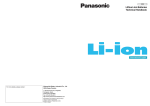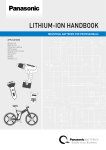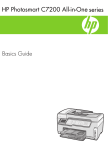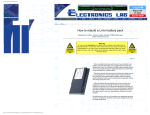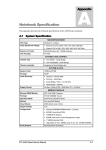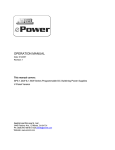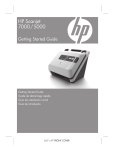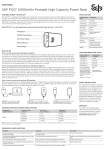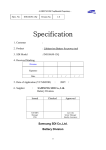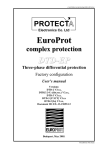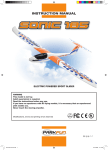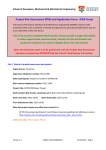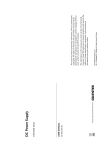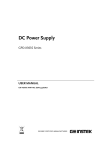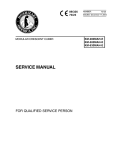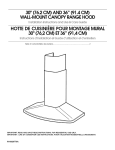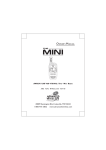Download Panasonic Lithium Ion Hanbook
Transcript
Lithium Ion Batteries Technical Handbook ’99 International English Version PDF File Technical Handbook Copyright 1999 Matsushita Battery Industrial Co., Ltd. All rights Reserved. No part of this technical handbook pdf file may be changed, altered, reproduced in any form or by any means without the prior written permission of Matsushita Battery Industrial Co., Ltd. NOTICE TO READERS It is the responsibility of each user to ensure that each battery application system is adequately designed safe and compatible with all conditions encountered during use, and in conformance with existing standards and requirements. Any circuits contained herein are illustrative only and each user must ensure that each circuit is safe and otherwise completely appropriate for the desired application. This literature contains information concerning cells and batteries manufactured by Matsushita Battery Industrial Co., Ltd. This information is generally descriptive only and is not intended to make or imply any representation guarantee or warranty with respect to any cells and batteries. Cell and battery designs are subject to modification without notice. All descriptions and warranties are solely as contained in formal offers to sell or quotations made by Matsushita Battery Industrial Co., Ltd., Panasonic Sales Companies and Panasonic Agencies. LITHIUM ION BATTERIES: TABLE OF CONTENTS Lithium Ion Batteries: Table of Contents Notes and Precautions ................................................................... 2 Safety Precautions for the Lithium Ion Battery Pack .................. 4 Overview of Lithium Ion Batteries ................................................ 6 Features of Lithium Ion Batteries .................................................. 8 Overcharge/Overdischarge/Overcurrent Safety Circuits .......... 9 How to Charge the Batteries ....................................................... 11 • Flowchart for Charging the Lithium Ion Battery Packs Glossary of Terminology for Lithium Ion Batteries .................... 13 Specification Summary Table ....................................................... 14 Individual Data Sheets .................................................................. 15 Battery Pack Specification Checklist .......................................... 26 Charger Specification Checklist .................................................. 27 LITHIUM ION BATTERIES HANDBOOK, PAGE 1 SEPTEMBER 1999 NOTES AND PRECAUTIONS • Safety Precautions for the Lithium Ion Battery Pack Use of Lithium Ion Batteries and the Design of Equipment That Uses These Batteries In general, lithium ion batteries are used in battery packs that contain both lithium ion batteries and battery protection circuits. Both items are sealed in a container made of a material such as resin so that the battery pack cannot be easily disassembled. 1. Charging the Batteries The “constant voltage/constant current” method is used to charge lithium ion batteries. (See Figure below.) Schematic diagram of the charging process (assuming a single cell) Constant voltage/constant current Voltage MAX4.20V Voltage 0.7CmA Current Current Duration (1) Charge Voltage The maximum voltage is 4.2 V x the number of cells connected in series. (2) Charge Current We recommend 0.7 CmA. When the voltage per cell is 2.9V or less, charge using a charge current of 0.1CmA or less. (Contact Panasonic for information regarding pulse charging.) (3) Charge Temperature The batteries should be charged at temperatures between 0°C and 45°C. (4) Reverse-polarity Charging Verify the polarity of the batteries before charging to insure that they are never charged with the polarity reversed. 2. Discharging the Batteries (1) Discharge Current The current should be maintained at 1.0 CmA or less (Consult Panasonic if you plan to discharge the batteries with a current in excess of 1.0 CmA). (2) Discharge Temperature The batteries should be discharged at a temperature between -10°C and +60°C. (Consult Panasonic if you plan to discharge the batteries at temperatures less than -10°C.) (3) Discharge Termination Voltage Avoid discharging at voltages less than 3.0 V per cell. Overdischarge can damage the performance of the battery. Equip the unit with a mechanism to prevent overdischarge, especially in situations where the user may forget to turn the equipment off. LITHIUM ION BATTERIES HANDBOOK, PAGE 2 SEPTEMBER 1999 NOTES AND PRECAUTIONS - CONTINUED 3. Equipment Design (1) Installing Battery Packs in the Equipment To avoid damage to the battery pack, make sure that the battery pack is positioned away from heat sources in the equipment or in the battery charger. (2) Mechanisms to Prevent Dropping Be sure to use a battery pack lock mechanism to prevent the battery pack from being ejected when the equipment is dropped or receives a sudden impact. (3) Preventing Short Circuits and Reversed Connections Use a terminal structure that makes it unlikely that the terminals will be shorted by metallic necklaces, clips, hairpins, etc. Structure the battery and the terminals to the battery in such a way that the battery pack cannot be put in backwards when installed in the charger or the equipment. (4) Inclusion in Other Equipment If the battery is built into other equipment, use caution to strictly avoid designing airtight battery compartments. (5) Terminal Materials in the External Equipment Use materials that are highly resistant to corrosion (such as nickel or nickel-coated copper). If contact resistance is an issue, we recommend that you use contact plating (such as gold plating) on the terminals. 4. Storing the Batteries The batteries should be stored at room temperature, charged to about 30 to 50% of capacity. We recommend that batteries be charged about once per year to prevent overdischarge. 5. Use of the Batteries See the section on “Safety Precautions for the Lithium Ion Battery Pack.” 6. Other The Chemical Reaction Because batteries utilize a chemical reaction they are actually considered a chemical product. As such, battery performance will deteriorate over time even if stored for a long period of time without being used. In addition, if the various usage conditions such as charge, discharge, ambient temperature, etc. are not maintained within the specified ranges the life expectancy of the battery may be shortened or the device in which the battery is used may be damaged by electrolyte leakage. If the batteries cannot maintain a charge for long periods of time, even when they are charged correctly, this may indicate it is time to change the battery. 7. Please Note The performance and life expectancy of batteries depends heavily on how the batteries are used. In order to insure safety, be sure to consult with Panasonic in advance regarding battery charging and discharging specifications and equipment structures when designing equipment that includes these batteries. Please Note: Panasonic assumes no liability for problems that occur when the Notes and Precautions for use listed above are not followed. LITHIUM ION BATTERIES HANDBOOK, PAGE 3 SEPTEMBER 1999 SAFETY PRECAUTIONS FOR THE LITHIUM ION BATTERY PACK • Safety Warnings 1. When Using the Battery ! WARNING (1) Misusing the battery may cause the battery to get hot, explode, or ignite and cause serious injury. Be sure to follow the safety rules listed below: • Do not place the battery in fire or heat the battery. • Do not install the battery backwards so that the polarity is reversed. • Do not connect the positive terminal and the negative terminal of the battery to each other with any metal object (such as wire). • Do not carry or store the batteries together with necklaces, hairpins, or other metal objects. • Do not pierce the battery with nails, strike the battery with a hammer, step on the battery, or otherwise subject it to strong impacts or shocks. • Do not solder directly onto the battery. • Do not expose the battery to water or salt water, or allow the battery to get wet. (2) Do not disassemble or modify the battery. The battery contains safety and protection devices which, if damaged, may cause the battery to generate heat, explode or ignite. (3) Do not place the battery on or near fires, stoves, or other high-temperature locations. Do not place the battery in direct sunshine, or use or store the battery inside cars in hot weather. Doing so may cause the battery to generate heat, explode, or ignite. Using the battery in this manner may also result in a loss of performance and a shortened life expectancy. ! CAUTION (1) If the device is to be used by small children, the caregiver should explain the contents of the user’s manual to the children. The caregiver should provide adequate supervision to insure that the device is being used as explained in the user’s manual. (2) When the battery is worn out, insulate the terminals with adhesive tape or similar materials before disposal. (3) Immediately discontinue use of the battery if, while using, charging, or storing the battery, the battery emits an unusual smell, feels hot, changes color, changes shape, or appears abnormal in any other way. Contact your sales location or Panasonic if any of these problems are observed. (4) Do not place the batteries in microwave ovens, high-pressure containers, or on induction cookware. (5) In the event that the battery leaks and the fluid gets into one’s eye, do not rub the eye. Rinse well with water and immediately seek medical care. If left untreated the battery fluid could cause damage to the eye. 2. While Charging ! WARNING (1) Be sure to follow the rules listed below while charging the battery. Failure to do so may cause the battery to become hot, explode, or ignite and cause serious injury. • When charging the battery, either use a specified battery charger or otherwise insure that the battery charging conditions specified by Panasonic are met. • Do not attach the batteries to a power supply plug or directly to a car’s cigarette lighter. • Do not place the batteries in or near fire, or into direct sunlight. When the battery becomes hot, the builtin safety equipment is activated, preventing the battery from charging further, and heating the battery can destroy the safety equipment and can cause additional heating, breaking, or ignition of the battery. (2) Do not continue charging the battery if it does not recharge within the specified charging time. Doing so may cause the battery to become hot, explode, or ignite. LITHIUM ION BATTERIES HANDBOOK, PAGE 4 SEPTEMBER 1999 SAFETY PRECAUTIONS FOR THE LITHIUM ION BATTERY PACK - CONTINUED ! CAUTION The temperature range over which the battery can be charged is 0°C to 45°C. Charging the battery at temperatures outside of this range may cause the battery to become hot or to break. Charging the battery outside of this temperature range may also harm the performance of the battery or reduce the battery’s life expectancy. 3. When Discharging the Battery ! WARNING Do not discharge the battery using any device except for the specified device. When the battery is used in devices aside from the specified device it may damage the performance of the battery or reduce its life expectancy, and if the device causes an abnormal current to flow, it may cause the battery to become hot, explode, or ignite and cause serious injury. ! CAUTION The temperature range over which the battery can be discharged is -10°C to 60°C. Use of the battery outside of this temperature range may damage the performance of the battery or may reduce its life expectancy. To insure the safe use of this battery, contact Panasonic when designing a device that uses this battery. LITHIUM ION BATTERIES HANDBOOK, PAGE 5 SEPTEMBER 1999 OVERVIEW OF LITHIUM ION BATTERIES Meeting the Needs of Portable Electronic Devices: Lithium Ion Batteries • Overview Panasonic lithium ion batteries, products of Panasonic’s long experience with batteries and leading-edge battery technology, are excellent sources for high-energy power in a variety of portable devices, such as portable computers and cellular phones. Light weight and boasting high voltage ratings (3.7 V), these high-energy density batteries provide a variety of features that will contribute to the weight reduction and downsizing of portable products. • Structure The lithium ion battery has a three-layer, coiled structure within its case. These three layers are comprised of a positive electrode plate (made with lithium cobalt oxide as its chief active ingredient), a negative electrode plate (made with a specialty carbon as its chief active ingredient), and a separator layer. The Structure of Lithium Ion Batteries (Cylindrical) Positive Terminal PTC Element Exhaust Gas Hole Anti-Explosive Valve Gasket Positive Terminal Lead Separators Insulation Plate The battery is equipped with a variety of measures to insure safety, along with an anti-explosion valve that releases gas if the internal pressure exceeds a specific value, thereby preventing the battery from explodeing. • Negative Electrode Negative Terminal Lead Case Positive Electrode Insulation Plate Safety Panasonic’s lithium ion batteries (CGR17500, CGR17670HC, CGR18650H, CGP30486, CGP345010, and CGP34506) have obtained UL1642 approval. LITHIUM ION BATTERIES HANDBOOK, PAGE 6 SEPTEMBER 1999 OVERVIEW THE LITHIUM ION BATTERIES - CONTINUED • Battery Reaction The lithium ion battery makes use of lithium cobalt oxide (which has superior cycling properties at high voltages) as the positive electrode and a highly-crystallized specialty carbon as the negative electrode. It uses an organic solvent, optimized for the specialty carbon, as the electrolytic fluid. The chemical reactions for charge and discharge are as shown below: Charge Positive Electrode + Li1-x CoO2 + xLi + xe- LiCoO2 Discharge Charge Negative Electrode + C + xLi + xe- CLix Discharge Charge Battery as a Whole LiCoO2 + C Li1-x CoO2 + CLix Discharge The principle behind the chemical reaction in the lithium ion battery is one where the lithium in the positive electrode lithium cobalt oxide material is ionized during charge, and moves from layer to layer in the negative electrode. During discharge, the ions move to the positive electrode and return to the original compound. Schematic Diagram of the Chemical Reaction of the Lithium Ion Battery Positive Electrode Negative Electrode Charge Li + Co O Li Li + Discharge LiCoO2 Specialty Carbon LITHIUM ION BATTERIES HANDBOOK, PAGE 7 SEPTEMBER 1999 FEATURES OF THE LITHIUM ION BATTERIES High Energy Density Because the lithium ion batteries are high voltage/light weight batteries, they boast a higher energy density than rechargeable nickel cadmium (Ni-Cd) batteries or nickel metal hydride (Ni-MH) batteries. 200 Mass Energy Density (Wh/kg) • Lithium-Ion Batteries 150 100 Nickel Hydride Batteries Ni-Cd Batteries 50 0 0 50 100 150 200 250 300 350 400 450 500 Volumetric Energy Density (Wh/ ) • High Voltage Lithium ion batteries produce 3.7 volts, approximately three times the voltage of rechargeable Ni-Cd batteries or Ni-MH batteries. This will make it possible to make smaller, lighter equipment. Ni-Cd Ni-Cd Ni-Cd Li-Ion No Memory Effect Lithium ion batteries have none of the memory effects seen in rechargeable Ni-Cd batteries (“memory effect” refers to the phenomenon where the apparent discharge capacity of a battery is reduced when it is repetitively discharged incompletely and then recharged). Battery: CGR17500 4.0 Voltage (V) • One cycle One cycle 3.5 One cycle One cycle 250 cycles 3.0 Discharge: 133 mA at 20˚C 2.5 Charge: Constant voltage: 4.1 V, with a maximum of 500 mA current for two hours at 20˚C Discharge: 133 mA, completed after two hours, at 20˚C 0 2 2 2 2 0 2 Hold Time (h) 6 8 Flat Discharge Voltage The use of the specialty carbon creates an extremely flat discharge voltage profile, allowing the production of stable power throughout the discharge period of the battery. 5.0 Battery: CGR18650 Discharge: 250 mA 4.5 Voltage (V) • 4 Hold Time (h) 4.0 Panasonic's Specialty Carbon 3.5 3.0 Coke (Panasonic's Trial Product) 2.5 2.0 0 500 1000 1500 Discharge Capacity (mAh) LITHIUM ION BATTERIES HANDBOOK, PAGE 8 SEPTEMBER 1999 OVERCHARGE/OVERDISCHARGE/OVERCURRENT SAFETY CIRCUITS • The Functions of the Safety Circuits (Typical Functions) The voltages listed below are typical values and are not guaranteed. The charge voltage varies according to model number. 1. The Overcharge Safety Function The charge stops when the voltage per cell rises above 4.30 ± 0.05 V. The charge restarts when the voltage per cell falls below 4.00 ± 0.15 V. 2. The Overdischarge Safety Function The discharge stops when the voltage per cell falls below 2.3 ± 0.1 V. The discharge restarts when the voltage per cell rises above 3.0 ± 0.15 V. 3. The Overcurrent Safety Function The discharge is stopped when the output terminals are shorted. The discharge restarts when the short is removed. • Reference Example of the Safety Circuits Battery Pack Unusable Region 4.3V 4.2V Charge Batteries Safety Circuits Region Used by the Set Charger Discharge 3.0V Overdischarge Region 2.3V Unusable Region • The safety circuits in the diagram above are for overcharging, overdischarging, and overcurrent for a single cell battery pack. Please contact Panasonic when two or more cells are connected or when actually using this or other circuits. LITHIUM ION BATTERIES HANDBOOK, PAGE 9 SEPTEMBER 1999 OVERCHARGE/OVERDISCHARGE/OVERCURRENT SAFETY CIRCUITS - CONTINUED • Battery Pack Block Diagram (Reference Example) The diagram below shows a diagram of a lithium ion battery pack. The battery pack includes the batteries, the safety circuits, and thermistors. 1. The Safety Circuits 1.1 The Controller IC The controller IC measures the voltage for each cell (or for each parallel battery block) and shuts off a control switch to either prevent overcharging (if the voltage exceeds the specified voltage range) or to prevent overdischarging (if the voltage falls below the specified voltage range). Moreover, the voltage of the control switch is measured on both ends and in order to prevent overcurrent, both control switches are shut off if the voltage exceeds specifications. 1.2 The Control Switches The control switches usually comprise FET structures, and they turn off the charge or discharge depending on the output of the controller IC. 1.3 The Temperature Fuse (Reference Materials) If the control switches experience abnormal heating, this fuse cuts off the current (non-restoring). 2. The Thermistors The thermistors are included in order to accurately measure the battery temperature within the lithium ion battery packs. The battery or charger measures the resistance value of the thermistor between the Tterminal and the negative terminal and during the charging process, controls the charge current along with controlling until the charge is terminated. + Battery Pack Safety Circuits Controller IC • • T Thermistor - Temperature Fuse Control SW Control SW The battery pack must be equipped with a noise filter at the voltage detectors in the block diagram above to insure that outside noise does not cause the battery to malfunction. Please check against the final product. Please include a total charge timer and a charge completion timer on the charging circuit in order to provide redundant safety control. LITHIUM ION BATTERIES HANDBOOK, PAGE 10 SEPTEMBER 1999 HOW TO CHARGE THE BATTERIES We recommend the following charging process to insure the optimal performance of the lithium ion battery. • Applicable Battery Packs The discussion below assumes that the battery packs are equipped with internal safety circuits to prevent overcharging and overdischarging, and assumes that the battery is a single cell battery. • Charging Method The lithium ion battery can be charged by the constant voltage/constant current charging method found in the “Notes and Precautions” at the beginning of this document. (See page 2, “Notes and Precautions”) • Functions and Performance Required in the Charger (Recommendations) (1) Charge Voltage The voltage between the charging terminals should be no more than 4.20 V (Set this at 4.20 V (max) after taking into account fluctuations in power supply voltages, temperature deviations, etc.). The charge voltage varies according to model number. For example, please charge CGP30486 at 4.10 volt. (2) Charge Current The reference charge current should be 0.7 CmA. (3) Ambient Temperature of the Battery Pack During Charge 0°C to 45°C (Consult Panasonic if the battery pack is to be used outside of this temperature range). (4) Low-Voltage Battery Pack Charge When the voltage per cell is 2.9 V or less, charge using a charge current of 0.1 CmA or less. (5) Termination of Charging The system will determine that the battery is full by detecting the charge current. Stop charging once the current has reached 0.1 CmA to 0.07 CmA. Note that there will be some degree of variation for each individual battery. (6) Charge Timer A total charge timer and a charge completion timer should be included. (7) Countermeasures for Battery Problems Select an overvoltage guard in the power supply so that there will be no excessive voltage applied to the battery even if there is a problem with the power supply. • The discussion above assumes a single cell battery. If two or more cells will be used or if there are other situations, please consult with Panasonic. LITHIUM ION BATTERIES HANDBOOK, PAGE 11 SEPTEMBER 1999 FLOWCHART FOR CHARGING THE LITHIUM ION BATTERY PACKS Lithium Ion Battery Pack Charge Flowchart (Example) Reference example of charging a single-cell lithium ion battery pack OCV: Battery pack load open voltage START T1 tmin Battery pack insertion check tbat NO tmax Is the battery pack CV inserted? ichg YES A iset1 iset2 T2 Charge total timer count T1 T3 YES : Charge total timer count : Low temperature threshold setting value : Battery temperature : High temperature threshold setting value : Constant voltage : Charge current : Electrical current set value : Electrical current set value : Charge complete timer count : Recharge timer count Total timer end decision T1 > 720 minutes Battery temperature check tmin<tbat<tmax NO Wait A YES Is voltage check 1 (no load) higher than the charge completion voltage? 4.1 V or 4.2 V NO OCV<4.1V YES Voltage check 2 (no load) OCV>2.9V NO YES 0.7 CmA charge A NO 0.1 CmA charge CV mode post-transition Overdischarge check charge current check Enter into CV OCV voltage > 3V A ichg < iset1 YES YES Charge complete timer count T2 NO Charge complete timer end decision T2 < 120 minutes NO Re-charge timer count T3 Re-charge timer end decision T3 < 120 minutes YES YES A NO Charge stop current check A NO ichg<iset 2 YES Timeout error Overcharge error Charge complete LITHIUM ION BATTERIES HANDBOOK, PAGE 12 SEPTEMBER 1999 GLOSSARY OF TERMINOLOGY FOR LITHIUM ION BATTERIES • Words Relating to the Characteristics of Batteries Term Definition Energy Density The amount of energy that can be produced per unit mass or per unit volume. Energy density is expressed in units of Wh/kg, Wh/ , etc. Overcharge Continued charging after the battery has reached a fully charged state. Generally charging more than necessary is unsafe and will have a harmful influence on the performance of the battery. Overdischarge Discharge of the battery below the established ending voltage. Nominal Voltage The voltage that is used as the battery voltage listed on the battery. Cycle Life Characteristics An attribute that indicates the time it takes per charge and discharge cycle when the battery is repetitively charged and discharged under specified parameters. Time Ratio (C) This metric is used to indicate the magnitude of the electrical current during charge or discharge. It is indicated in terms of a multiple of a value that indicates the capacity of the battery, and the value is expressed in units of electrical current. Generally the electrical current for charge or discharge is expressed in terms of a multiplier of C. For example, if the capacity is 1500 mAh, we have the following: 0.1 C = 0.1 x 1500 mA = 150 mA 0.2 C = 0.2 x 1500 mA = 300 mA Self Discharge The amount to which the capacity of the battery is reduced without there being any current discharged through an external circuit. Ending Voltage The voltage that indicates the limit at which to stop the electrical discharge. This voltage roughly corresponds to the limit for use in practical applications. Amount of Charge This is the amount of electricity that is used in charging the battery. When there is the specified current during charge, this is the integral of the current value over the charging time. The units are ampere hours (Ah). High Current Discharge This refers to a discharge that has a large electrical current relative to the capacity of the battery. This is also known as "high rate discharge." Standard Capacity The standard value for the amount of electricity that can be used from a completely charged battery at the standard temperature, with a standard discharge current to the ending voltage. The units are ampere hours (Ah). Fresh Battery A "fresh battery" refers to a battery that has been charged and discharged five or less times within one month of manufacturing. Capacity This is the electrical ability of the battery. Normally this refers to ampere hours of capacity, and the units are either Ah or C (coulombs). Capacity Retention Ratio If the standard capacity is indexed to 100, this is the capacity ratio when the battery is first discharged (under specified conditions) after it has been stored for a specified period of time. Capacity Recovery Ratio If the standard capacity is indexed to 100, this is the maximum capacity ratio that can be obtained after repetitively charging and discharging the battery under specified conditions after it has been stored a specific period of time. Fluid Leakage This refers to the leakage of electrolytic fluid to the outer surface of the battery. LITHIUM ION BATTERIES HANDBOOK, PAGE 13 SEPTEMBER 1999 SPECIFICATION SUMMARY TABLE Specifications S h ap e Model Number Cylindrical Prismatic NEW CGR17500 CGR17670HC CGR18650H CGP30486 CGP34506 CGP345010 Typical Nominal Capacity* Voltage (v) (mAh) 3.7 830 1250 1500 630** 875 1400 Diameter / Thickness Height (mm) Width (mm) (mm) Approx. Weight (g) 49.5 ± 0.5 66.7 ± 0.3 64.7 ± 0.3 47.5 ± 0.5 49.5 ± 0.5 49.8 ± 0.5 25 35 40 23 29 42 17.0 +0 -1.0 18.3 ± 0.5 29.8 ± 0.3 33.8 ± 0.3 34.0 ± 0.3 ------6.4 ± 0.3 6.5 ± 0.3 10.3 ± 0.3 * 4.2V Charge ** 4.1V Charge LITHIUM ION BATTERIES HANDBOOK, PAGE 14 SEPTEMBER 1999 LITHIUM ION BATTERIES (INDIVIDUAL DATA SHEETS) CGR17500: Cylindrical Model CGR17500 Discharge Characteristics 5.0 Charge Conditions: Constant voltage/constant current, 4.2 V, 550 mA (max.), 2 hours, 20˚C. 4.5 Discharge Conditions: Constant current up to 3.0V at 20˚C. Voltage (V) External Dimensions (mm) *2 +0 17.0 - 1.0 (+) 156mA 4.0 780mA 3.5 1560mA 3.0 2.5 49.5±0.5 0 5.0 200 400 600 Capacity (mAh) 800 1000 Charge Conditions: Constant voltage/constant current, 4.2 V, 550 mA (max.), 2 hours, 20˚C. Discharge Conditions: Constant current 156 mA. 4.5 (With Tube) Voltage (V) 20˚C 4.0 45˚C 60˚C 3.5 (-) 0˚C -10˚C 3.0 2.5 0 200 400 600 800 1000 Capacity (mAh) Specifications 3.7V 830mAh 17.0 +0 -1.0 mm 49.5±0.5mm Approx. 25g *1 After a fresh battery has been charged at constant voltage/constant current (4.2 V, 550 mA (max), 2 hours, 20°C), the average of the capacity (ending voltage of 3 V at 20°C) that is discharged at a standard current (156 mA). *2 Dimensions of a fresh battery 5.0 4.5 Voltage (V) Nominal Voltage Standard Capacity *1 Diameter Dimentions*2 Height Weight Charge Conditions: Constant voltage/constant current, 4.2 V, 550 mA (max.), 2 hours, 20˚C. Discharge Conditions: Constant current 780mA. 45˚C 4.0 20˚C 3.5 3.0 -10˚C 0˚C 2.5 0 4.5 Voltage (V) 4.0 400 600 Capacity (mAh) 800 5.0 Charge Conditions: Constant voltage/constant current, 4.2 V, 550 mA (max.), 2 hours, 20˚C. 4.5 Discharge Conditions: Constant wattage up to 3.0 V at 20˚C. 4.0 Voltage 3.5 3.0 3.5 3.0 2.5 2W 2.0 2.5 1.5 2.0 Current 1.5 1.0 0 1000 0.5 1.0 1.5 2.0 2.5 3.0 3.5 Current (A) 5.0 200 1.0 0.5 0 4.0 Discharge Capacity (Wh) LITHIUM ION BATTERIES HANDBOOK, PAGE 15 SEPTEMBER 1999 LITHIUM ION BATTERIES (INDIVIDUAL DATA SHEETS) Storage Characteristics Discharge Characteristics 5.0 3.0 3.5 3.0 2.5 4W 2.0 2.5 1.5 2.0 Current 1.5 Capacity Retention Ratio (%) Voltage 3.5 90 Current (A) 4.0 Voltage (V) 100 5.0 Charge Conditions: Constant voltage/constant current, 4.2 V, 550 mA (max.), 2 hours, 20˚C. 4.5 Discharge Conditions: Constant wattage up to 3.0 V at 20˚C. 4.0 4.5 1.0 0.5 1.0 0 0.5 1.0 1.5 2.0 CGR17500 2.5 3.0 3.5 20˚C 80 RETENTION 70 60 50 40 Storage Conditions: Fully charged, 20˚C. Charge Conditions: Constant voltage/constant current, 4.2 V, 550 mA (max.), 2 hours, 20˚C. Discharge Conditions: Constant current 156 mA up to 3.0V at 20˚C. 30 20 10 0 4.0 0 0 1 2 Discharge Capacity (WH) 5.0 3.0 3.0 2.5 6W 2.0 2.5 2.0 Capacity Recovery Ratio (%) 3.5 Voltage 3.5 1.5 Current Current (A) Voltage (V) 4.0 1.0 1.5 0.5 1.0 0 0.5 1.0 1.5 2.0 2.5 3.0 3.5 5 6 7 100 5.0 Charge Conditions: Constant voltage/constant current, 4.2 V, 550 mA (max.), 2 hours, 20˚C. 4.5 Discharge Conditions: Constant wattage up to 3.0 V at 20˚C. 4.0 4.5 3 4 Period (Month) 90 20˚C 80 RECOVERY 70 60 50 40 Storage Conditions: Fully charged, 20˚C. Charge Conditions: Constant voltage/constant current, 4.2 V, 550 mA (max.), 2 hours, 20˚C. Discharge Conditions: Constant current 156 mA up to 3.0V at 20˚C. 30 20 10 0 4.0 0 0 1 2 Discharge Capacity (WH) 3 4 Period (Month) 5 6 7 Charge Characteristics 1750 4.00 1500 3.75 1250 3.50 Capacity 3.00 500 Current 2.75 2.50 1000 750 3.25 0 0.5 1.0 Time (h) 1.5 2.0 250 0 2.5 Storage Conditions: 20˚C for 6 months from fully charged. Charge Conditions: Constant voltage/constant current, 4.2 V, 550 mA (max.), 2 hours, 20˚C. Discharge Conditions: Constant current 156 mA up to 3.0V at 20˚C. 4.5 Voltage (V) Voltage 4.25 Voltage (V) 2250 2000 4.50 5.0 2500 Capacity (mAh) Charge Conditions: Constant voltage/constant current, 4.2 V, 4.75 550 mA (max.), 2 hours, 20˚C. Current (mA) 5.00 4.0 Before Storage 3.5 3.0 After Storage (First Time/Capacity Retention) After Storage (Second Time/Capacity Recovery) 2.5 0 200 400 600 Capacity (mAh) 800 1000 Cycle Life Characteristics 1000 Capacity (mAh) 800 600 400 Charge Conditions: Constant voltage/constant current, 4.2 V, 200 550 mA (max.), 2 hours, 20˚C. Discharge Conditions: Constant current 780 mA up to 3.0V at 20˚C. Charge/Discharge Rest Period: 20 min. 0 0 100 200 300 400 500 Number of Cycles (Cycles) LITHIUM ION BATTERIES HANDBOOK, PAGE 16 SEPTEMBER 1999 LITHIUM ION BATTERIES (INDIVIDUAL DATA SHEETS) CGR17670HC: Cylindrical Model CGR17670HC Discharge Characteristics 5.0 Charge Conditions: Constant voltage/constant current, 4.2 V, 840 mA (max.), 2 hours, 20˚C. Discharge Conditions: Constant current up to 3.0V at 20˚C. 4.5 Voltage (V) External Dimensions (mm) *2 +0 - 1.0 17.0 (+) 4.0 240mA 1200mA 3.5 2400mA 3.0 2.5 66.7±0.3 0 200 400 600 800 Capacity (mAh) 1000 1200 1400 Voltage (V) 5.0 Charge Conditions: Constant voltage/constant current, 4.2 V, 840 mA (max.), 2 hours, 20˚C. 4.5 Discharge Conditions: Constant current 240 mA. 20˚C 4.0 60˚C 45˚C 3.5 10˚C 3.0 0˚C -10˚C (With Tube) 2.5 (-) 0 200 400 600 800 Capacity (mAh) 1000 1200 1400 Specifications 3.7V 1250mAh 17.0 +0 -1.0 mm 66.7±0.3mm Approx. 35g Charge Conditions: Constant voltage/constant current, 4.2 V, 840 mA (max.), 2 hours, 20˚C. 4.5 Discharge Conditions: Constant current 1200 mA. 4.0 20˚C 60˚C 3.5 45˚C 10˚C 3.0 0˚C -10˚C 2.5 0 5.0 4.5 Voltage (V) 4.0 200 400 600 800 Capacity (mAh) 1000 1400 5.0 Charge Conditions: Constant voltage/constant current, 4.2 V, 840 mA (max.), 2 hours, 20˚C. 4.5 Discharge Conditions: Constant wattage up to 3.0 V at 20˚C. 4.0 Voltage 3.5 3.0 3.5 3.0 2.5 2W 2.0 2.5 1.5 2.0 Current 1.5 1.0 0 1200 Current (A) *1 After a fresh battery has been charged at constant voltage/constant current (4.2 V, 840 mA (max), 2 hours, 20°C), the average of the capacity (ending voltage of 3 V at 20°C) that is discharged at a standard current (240 mA). *2 Dimensions of a fresh battery 5.0 Voltage (V) Nominal Voltage Standard Capacity *1 Diameter Dimentions*2 Height Weight 1.0 0.5 1.0 2.0 3.0 4.0 5.0 0 6.0 Discharge Capacity (Wh) LITHIUM ION BATTERIES HANDBOOK, PAGE 17 SEPTEMBER 1999 LITHIUM ION BATTERIES (INDIVIDUAL DATA SHEETS) Storage Characteristics Discharge Characteristics 3.5 Voltage 3.5 3.0 90 3.0 Current (A) 4.0 Voltage (V) 100 5.0 Charge Conditions: Constant voltage/constant current, 4.2 V, 840 mA (max.), 2 hours, 20˚C. 4.5 Discharge Conditions: Constant wattage up to 3.0 V at 20˚C. 4.0 4.5 2.5 4W 2.0 2.5 1.5 2.0 Current 1.0 1.5 0.5 1.0 0 1.0 3.0 2.0 4.0 5.0 Capacity Retention Ratio (%) 5.0 CGR17670HC 0 6.0 20˚C 80 RETENTION 70 60 50 40 Storage Conditions: Fully charged. Charge Conditions: Constant voltage/constant current, 4.2 V, 840 mA (max.), 2 hours, 20˚C. Discharge Conditions: Constant current 240 mA up to 3.0V at 20˚C. 30 20 10 0 0 1 2 Discharge Capacity (Wh) 3.5 Voltage 3.5 3.0 3.0 2.5 6W 2.0 2.5 2.0 1.5 Current 1.0 1.5 0.5 1.0 0 1.0 3.0 2.0 4.0 5.0 6 7 90 Current (A) Voltage (V) 4.0 5 100 5.0 Charge Conditions: Constant voltage/constant current, 4.2 V, 840 mA (max.), 2 hours, 20˚C. 4.5 Discharge Conditions: Constant wattage up to 3.0 V at 20˚C. 4.0 4.5 0 6.0 Capacity Recovery Ratio (%) 5.0 3 4 Period (Month) RECOVERY 70 60 50 40 Storage Conditions: Fully charged. Charge Conditions: Constant voltage/constant current, 4.2 V, 840 mA (max.), 2 hours, 20˚C. Discharge Conditions: Constant current 240 mA up to 3.0V at 20˚C. 30 20 10 0 Discharge Capacity (Wh) 20˚C 80 0 1 2 3 4 Period (Month) 5 6 7 Charge Characteristics Charge Conditions: Constant voltage/constant current, 4.2 V, 840 mA (max.), 2 hours, 20˚C. 2000 1600 4.5 4.0 1200 Capacity 800 3.5 3.0 400 Current 2.5 0 0.5 1.0 Time (h) 1.5 Current (mA) Voltage (V) Voltage Capacity (mAh) 5.0 0 2.5 2.0 Cycle Life Characteristics 2000 Capacity (mAh) 1500 Charge Conditions: Constant voltage/constant current, 4.2 V, 840 mA (max.), 2 hours, 20˚C. Discharge Conditions: Constant current 1200 mA up to 3.0V at 20˚C. Charge/Discharge Rest Period: 20 min. 1000 500 0 0 100 200 300 400 500 Number of Cycles (Cycles) LITHIUM ION BATTERIES HANDBOOK, PAGE 18 SEPTEMBER 1999 LITHIUM ION BATTERIES (INDIVIDUAL DATA SHEETS) CGR18650H: Cylindrical Model CGR18650H Discharge Characteristics 5.0 Charge Conditions: Constant voltage/constant current, 4.2 V, 980 mA (max.), 2 hours, 20˚C. Discharge Conditions: Constant current up to 3.0 V at 20˚C. 4.5 Voltage (V) External Dimensions (mm) *2 18.3±0.5 (+) 4.0 280mA 1400mA 3.5 2800mA 3.0 2.5 64.7±0.3 0 200 400 600 800 1000 1200 Capacity (mAh) 1400 1600 1800 Voltage (V) 5.0 Charge Conditions: Constant voltage/constant current, 4.2 V, 980 mA (max.), 2 hours, 20˚C. 4.5 Discharge Conditions: Constant current 280 mA. 4.0 20˚C 60˚C 45˚C 3.5 0˚C 10˚C 3.0 -10˚C (With Tube) 2.5 (-) 0 200 400 600 800 1000 1200 Capacity (mAh) 1400 1600 1800 Specifications 3.7V 1500mAh 18.3±0.5mm 64.7±0.3mm Approx. 40g Charge Conditions: Constant voltage/constant current, 4.2 V, 980 mA (max.), 2 hours, 20˚C. 4.5 Discharge Conditions: Constant current 1400 mA. 4.0 20˚C 60˚C 3.5 45˚C 10˚C 3.0 0˚C -10˚C 2.5 0 5.0 Discharge Voltage (V) 4.5 4.0 200 400 600 800 1000 1200 Capacity (mAh) 1400 1600 5.0 Charge Conditions: Constant voltage/constant current, 4.2 V, 980 mA (max.), 2 hours, 20˚C. 4.5 Discharge Conditions: Constant wattage up to 3.0 V at 20˚C. 4.0 3.5 Voltage 3.5 3.0 3.0 2.5 2W 2.0 2.5 1.5 2.0 Current 1.0 1.5 1.0 0 1800 Current (A) *1 After a fresh battery has been charged at constant voltage/constant current (4.2 V, 980 mA (max), 2 hours, 20°C), the average of the capacity (ending voltage of 3 V at 20°C) that is discharged at a standard current (280 mA). *2 Dimensions of a fresh battery 5.0 Voltage (V) Nominal Voltage Standard Capacity *1 Diameter Dimentions*2 Height Weight 0.5 1 2 3 4 5 6 7 0 Discharge Capacity (Wh) LITHIUM ION BATTERIES HANDBOOK, PAGE 19 SEPTEMBER 1999 LITHIUM ION BATTERIES (INDIVIDUAL DATA SHEETS) Storage Characteristics Discharge Characteristics 3.5 Voltage 3.5 3.0 90 3.0 Current (A) 4.0 Voltage (V) 100 5.0 Charge Conditions: Constant voltage/constant current, 4.2 V, 980 mA (max.), 2 hours, 20˚C. 4.5 Discharge Conditions: Constant wattage up to 3.0 V at 20˚C. 4.0 4.5 2.5 4W 2.0 2.5 1.5 2.0 Current 1.0 1.5 0.5 1.0 0 1 2 3 4 5 6 7 Capacity Retention Ratio (%) 5.0 CGR18650H 0 20˚C 80 RETENTION 70 60 50 40 Storage Conditions: Fully charged, 20˚C. Charge Conditions: Constant voltage/constant current, 4.2 V, 980 mA (max.), 2 hours, 20˚C. Discharge Conditions: Constant current 280 mA up to 3.0V at 20˚C. 30 20 10 0 0 1 2 Discharge Capacity (Wh) 3.5 Voltage 3.5 3.0 3.0 Current (A) Voltage (V) 4.0 2.5 6W 2.0 2.5 1.5 2.0 Current 1.0 1.5 0.5 1.0 0 1 2 3 4 5 6 7 5 6 7 100 5.0 Charge Conditions: Constant voltage/constant current, 4.2 V, 980 mA (max.), 2 hours, 20˚C. 4.5 Discharge Conditions: Constant wattage up to 3.0 V at 20˚C. 4.0 4.5 Capacity Recovery Ratio (%) 5.0 3 4 Period (Month) 90 20˚C 80 RECOVERY 70 60 50 40 Storage Conditions: Fully charged, 20˚C. Charge Conditions: Constant voltage/constant current, 4.2 V, 980 mA (max.), 2 hours, 20˚C. Discharge Conditions: Constant current 280 mA up to 3.0V at 20˚C. 30 20 10 0 0 Discharge Capacity (Wh) 0 1 2 3 4 Period (Month) 5 6 7 Charge Characteristics Voltage (V) 4.5 Capacity Voltage 4.0 1600 1200 800 3.5 400 3.0 2.5 2000 Current 0 0.5 1.0 Time (h) 1.5 Capacity (mAh) Charge Conditions: Constant voltage/constant current, 4.2 V, 980 mA (max.), 2 hours, 20˚C. Current (mA) 5.0 0 2.5 2.0 Cycle Life Characteristics 2000 Capacity (mAh) 1500 Charge Conditions: Constant voltage/constant current, 4.2 V, 980 mA (max.), 2 hours, 20˚C. Discharge Conditions: Constant current 1400 mA up to 3.0V at 20˚C. Charge/Discharge Rest Period: 20 min. 1000 500 0 0 100 200 300 400 500 Number of Cycles (Cycles) LITHIUM ION BATTERIES HANDBOOK, PAGE 20 SEPTEMBER 1999 LITHIUM ION BATTERIES (INDIVIDUAL DATA SHEETS) CGP30486: Prismatic Model CGP30486 Discharge Characteristics 5.0 Charge Conditions: Constant voltage/constant current, 4.1 V, 420 mA (max.), 2 hours, 20˚C. Discharge Conditions: Constant current, 20˚C. 4.5 Voltage (V) External Dimensions (mm) *2 29.8±0.3 120mA 4.0 3.5 1200mA 600mA 3.0 6.4 ± 0.3 2.5 47.5 ± 0.5 (+) 0 5.0 Voltage (V) 200 300 400 500 Capacity (mAh) 600 700 800 Charge Conditions: Constant voltage/constant current, 4.1 V, 420 mA, 2 hours, 20˚C. Discharge Conditions: Constant current 120 mA. 4.5 (With Tube) 100 4.0 20˚C 3.5 0˚C -10˚C (-) 3.0 2.5 0 200 400 Capacity (mAh) 600 800 Specifications 3.7V 630mAh 29.8±0.3mm 47.5±0.5mm 6.4±0.3mm Approx. 23g *1 After a fresh battery has been charged at constant voltage/constant current (4.1 V, 420 mA (max), 2 hours, 20°C), the average of the capacity (ending voltage of 3 V at 20°C) that is discharged at a standard current (120 mA). *2 Dimensions of a fresh battery 5.0 Charging Conditions: Constant voltage/constant current, 4.1 V, 420 mA (max.), 2 hours, 20˚C. Discharge Conditions: Constant current, 600mA. 4.5 Voltage (V) Nominal Voltage Standard Capacity *1 Width H eight Dimentions*2 Thickness Weight 4.0 20˚C 3.5 3.0 -10˚C 0˚C 2.5 0 100 200 300 400 500 Capacity (mAh) 600 700 800 Charge Characteristics 4.5 800 640 Voltage (V) Capacity 4.0 480 Voltage 320 3.5 160 3.0 Current 2.5 0 0.5 1.0 Time (h) LITHIUM ION BATTERIES HANDBOOK, PAGE 21 1.5 2.0 Capacity (mAh) Charge Conditions: Constant voltage/constant current, 4.1 V, 420 mA (max.), 2 hours, 20˚C. Current (mA) 5.0 0 2.5 SEPTEMBER 1999 LITHIUM ION BATTERIES (INDIVIDUAL DATA SHEETS) Cycle Life Characteristics Storage Characteristics 800 100 Capacity Recovery Ratio (%) 700 600 Capacity (mAh) CGP30486 500 400 300 200 Charge Conditions: Constant voltage/constant current, 4.1 V, 420 mA (max.), 2 hours, 20˚C. 100 Discharge Conditions: Constant current 600 mA up to 3.0V at 20˚C. Charge/Discharge Rest Period: 20 min. 0 200 300 400 500 0 100 Number of Cycles (Cycles) 80 60 40 Storage Conditions: Fully charged, 20˚C. Charge Conditions: Constant voltage/constant current, 4.1 V, 420 mA (max.), 2 hours, 20˚C. Discharge Conditions: Constant current 120 mA up to 3.0V at 20˚C. 2 4 6 8 10 Length of Storage (Months) 20 0 0 Storage Characteristics 80 4.5 60 4.0 40 20 0 0 Storage Conditions: Fully charged, 20˚C. Charging Conditions: Constant voltage/constant current, 4.1 V, 420 mA (max.), 2 hours, 20˚C. Discharge Conditions: Constant current 120 mA up to 3.0V at 20˚C. 2 4 6 8 10 Length of Storage (Months) Voltage (V) 5.0 Capacity Maintenance Ratio (%) 100 Storage Conditions: 20˚C for 4 months from fully charged Charge Conditions: Constant voltage/constant current, 4.1 V, 420 mA (max.), 2 hours, 20˚C. Discharge Conditions: Constant current 120 mA up to 3.0V at 20˚C. Before Storage 3.5 After Storage (First Time/Capacity Retention) 3.0 After Storage (Second Time/Capacity Recovery) 2.5 0 100 200 300 400 500 Capacity (mAh) LITHIUM ION BATTERIES HANDBOOK, PAGE 22 600 700 800 SEPTEMBER 1999 LITHIUM ION BATTERIES (INDIVIDUAL DATA SHEETS) CGP345010: Prismatic Model CGP345010 Discharge Characteristics 5.0 Charge Conditions: Constant voltage/constant current, 4.2 V, 945 mA (max.), 2 hours, 20˚C. 4.5 Discharge Conditions: Constant current up to 3.0V at 20˚C. Voltage (V) External Dimensions (mm) *2 34.0±0.3 270mA 4.0 3.5 10.3 ± 0.3 2.5 49.8 ± 0.5 (+) 0 5.0 Voltage (V) 200 400 600 800 1000 Capacity (mAh) 1200 1400 1600 Charging Conditions: Constant voltage/constant current, 4.2 V, 945 mA (max.), 2 hours, 20˚C. Discharge Conditions: Constant current 1350 mA up to 3.0V at 20˚C. 4.5 (With Tube) 1350mA 2700mA 3.0 4.0 45˚C 20˚C 3.5 60˚C 3.0 (-) 0˚C 2.5 0 200 400 -10˚C 600 800 1000 Capacity (mAh) 1200 1400 1600 Specifications 5.0 Charge Conditions: Constant voltage/constant current, 4.2 V, 945 mA (max.), 2 hours, 20˚C. 4.5 Discharge Conditions: Constant wattage up to 3.0 V at 20˚C. 4.0 4.5 4.0 3.5 Voltage 3.5 3.0 3.0 2.5 2W 2.0 2.5 1.5 2.0 Current Current (A) *1 After a fresh battery has been charged at constant voltage/constant current (4.2 V, 945 mA (max), 2 hours, 20°C), the average of the capacity (ending voltage of 3 V at 20°C) that is discharged at a standard current (270 mA). *2 Dimensions of a fresh battery 5.0 1.0 1.5 0.5 1.0 0 1 2 3 4 5 6 7 0 Discharge Capacity (Wh) 5.0 5.0 Charge Conditions: Constant voltage/constant current, 4.2 V, 945 mA (max.), 2 hours, 20˚C. 4.5 Discharge Conditions: Constant wattage up to 3.0 V at 20˚C. 4.0 4.5 Voltage (V) 4.0 3.5 Voltage 3.5 3.0 3.0 2.5 4W 2.0 2.5 1.5 2.0 Current Current (A) 3.7V 1400mAh 34.0±0.3mm 49.8±0.5mm 10.3±0.3mm Approx. 42g Voltage (V) Nominal Voltage Standard Capacity *1 Width H eight Dimentions*2 Thickness Weight 1.0 1.5 0.5 1.0 0 1 2 3 4 5 6 7 0 Discharge Capacity (Wh) LITHIUM ION BATTERIES HANDBOOK, PAGE 23 SEPTEMBER 1999 LITHIUM ION BATTERIES (INDIVIDUAL DATA SHEETS) Discharge Characteristics 5.0 1800 3.0 3.0 2.5 6W 2.0 2.5 2.0 1.5 Current 1.0 1.5 0.5 1.0 0 1 2 3 4 5 6 7 0 Discharge Capacity (Wh) Capacity (mAh) Voltage 3.5 1500 3.5 Current (A) 4.0 Voltage (V) Cycle Life Characteristics 5.0 Charging Conditions: Constant voltage/constant current, 4.2 V, 945 mA (max.), 2 hours, 20˚C. 4.5 Discharge Conditions: Constant wattage up to 3.0 V at 20˚C. 4.0 4.5 CGP345010 1200 900 600 Charge Conditions: Constant voltage/constant current, 4.2 V, 945 mA (max.), 2 hours, 20˚C. 300 Discharge Conditions: Constant current 1350 mA up to 3.0V at 20˚C. Charge/Discharge Rest Period: 20 min. 0 200 300 400 0 100 Number of Cycles (Cycles) 500 Charge Characteristics Voltage (V) 4.5 2000 1600 Capacity Voltage 4.0 1200 3.5 800 3.0 400 Current 2.5 0 0.5 1.0 Time (h) 1.5 2.0 Capacity (mAh) Charge Conditions: Constant voltage/constant current, 4.2 V, 945 mA (max.), 2 hours, 20˚C. Current (mA) 5.0 0 2.5 LITHIUM ION BATTERIES HANDBOOK, PAGE 24 SEPTEMBER 1999 LITHIUM ION BATTERIES (INDIVIDUAL DATA SHEETS) CGP34506 NEW CGP34506: Prismatic Model Discharge Characteristics 5.0 Charge Conditions: Constant voltage/constant current, 4.2 V, 600 mA (max.), 2 hours, 20˚C. 4.5 Discharge Conditions: Constant current at 20˚C. External Dimensions (mm) *2 Voltage (V) 170mA 33.8±0.3 4.0 3.5 850mA 1700mA 3.0 6.5 ± 0.3 (+) 49.5 ± 0.5 2.5 0 5.0 Voltage (V) (-) 400 600 Capacity (mAh) 800 1000 1200 Charge Conditions: Constant voltage/constant current, 4.2 V, 600 mA (max.), 2 hours, 20˚C. Discharge Conditions: Constant current 850 mA. 4.5 (With Tube) 200 4.0 20˚C 3.5 3.0 0˚C -10˚C 2.5 0 200 400 600 Capacity (mAh) 800 1000 1200 Specifications 5.0 Charge Conditions: Constant voltage/constant current, 4.2 V, 600 mA (max.), 2 hours, 20˚C. 4.5 Voltage 4.0 Capacity 3.5 1200 900 600 3.0 Current 2.5 1500 0 0.5 1.0 1.5 2.0 300 0 2.5 Current (mA) *1 After a fresh battery has been charged at constant voltage/constant current (4.2 V, 600 mA (max), 2 hours, 20°C), the average of the capacity (ending voltage of 3 V at 20°C) that is discharged at a standard current (170 mA). *2 Dimensions of a fresh battery Charge Characteristics Capacity (mAh) 3.7V 875mAh 33.8±0.3mm 49.5±0.5mm 6.5±0.3mm Approx. 29g Voltage (V) Nominal Voltage Standard Capacity *1 Width H eight Dimentions*2 Thickness Weight Time (h) LITHIUM ION BATTERIES HANDBOOK, PAGE 25 SEPTEMBER 1999 BATTERY PACK SPECIFICATION CHECKLIST Battery Pack Specification Checklist Fill in the blanks below to determine specifications when making inquiries or when ordering batteries. 1. Battery Pack: General 1) Schedule: (1) Completion of design evaluation: Month:____ Year:____ (2) Completion of mass production evaluation: Month:____ Year:____ (3) Start of delivery: Month: ____ Year ____ _____ k packs per month (Total volume: _____ k packs) (1) Domestic (2) Overseas (Name of country: ______) (1) Standard (where the standard is 0°C to 45°C) (2) Custom (_____°C to _____ °C) (1) Standard (where standard is 45 to 85%, non-condensing) (2) Custom (_____ % to _____ %) (1) No (2) Yes ((1) Automotive (2) Outdoors (3) Other (___________________)) (1) Electrical Appliance and Material Control Law (2) UL (3) Other (_________) (1) Customer (2) Panasonic (3) Other (_____________________) (1) Portable telephone (2) AV equipment (___________________) (3) Personal computer (4) Other (__________________________) (1) Required (2) Not required (if required, fill in item 3) 2) Number of units: 3) Delivery Destination: 4) Operating Temperature: 5) Ambient Humidity: 6) 7) 8) 9) Special Conditions for Use: Applicable Specifications: Applicable Recipient: Application: 10) FG (Fuel Gauge) 2. Battery Pack Basic Specifications 1) 2) 3) 4) 5) 6) 7) 8) 9) 10) 11) 12) 13) 14) 15) Battery Pack Configuration: Battery Pack Materials: Battery & Structure Used: Rated Capacity: Charging Method: Charge Current: Charge Time: Discharge Ending Voltage: Thermistor: Drop Strength: Flame Retardance Requirements: Dimensions: Weight: Label: Terminal Configuration: (1) Hard case (2) Soft pack (3) Other (_______________________) Specify (_____) 17500/17670HC/18650H/30486/345010/34506 (____ P x ____ S) _____ mAh (1) Fast (2) Standard (3) Other (_______________________) _____A _____ hours _____ V (1) Standard (Present/Absent) (Standard: 10 KW, 25°C) (2) Other (__________) (1) Present (_____ cm) (2) Absent (1) Present (_____) (2) Absent _____ width x _____ length x _____ height mm or less _____ g or less (1) Not required (2) Required (Details of label specified elsewhere.) (__________________________) 3. Fuel Gauge Specifications 1) Range of load currents: 2) Load current waveform: 3) Accuracy: 4) Display method: 5) Mode change 6) Communications data: 7) Charge function (_____ mA to _____ mA) (1) Wave height _____ mA (2) Conductive period _____ mSec (3) Stop period _____ mSec (1) ± 10% (2) ± 5% (3) Other (_________________) (1) LED (2) Communications (3) LED and communications (communications method ________________) (1) Not required (2) Required (Modes (suspend, etc.) (1) ______ (2) _________) (1) Remainder (2) Voltage (3) Current (4) Temperature (5) ID code (6) Other (______________________________) (1) Not required (2) Required LITHIUM ION BATTERIES HANDBOOK, PAGE 26 SEPTEMBER 1999 CHARGER SPECIFICATION CHECKLIST Charger Specification Checklist Fill in the blanks below to determine specifications when making inquiries or when ordering. 1. General 1) Start of Delivery: 2) Delivery Destination: 3) Operating Temperature: 4) Ambient Humidity: 5) 6) 7) 8) Special Conditions for Use: Applicable Specifications: Applicable Recipient: Application: Month:____ Year:____ Number of units: _____ per month (Total volume: ___________ units) (1) Domestic (2) Overseas (Name of country: ____________________) (1) Standard (where standard is 0°C to 45°C) (2) Custom (_____°C to _____ °C) (1) Standard (where standard is 45 to 85%, non-condensing) (2) Custom (_____ % to _____ %) (1) No (2) Yes ((1) Automotive (2) Outdoors (3) Other (___________________)) (1) Electrical Appliance and Material Control Law (2) UL (3) Other (_________) (1) Customer (2) Panasonic (3) Other (_________________________) (1) Portable telephone (2) AV equipment (_______________________) (3) Personal computer (4) Other (______________________________) 2. Basic Specifications 1) Battery Pack Compatibility: 2) 3) 4) 5) 6) 7) 8) 9) 10) 11) Charging Method: Charge Current: Charge Time: Charger Model: Display LED: Power Supply Voltage: Drop strength: Dimensions: Weight: Label: 17500/17670HC/18650H/30486/345010/34506 (___P x ___ S) FG((1) Present (____) (2) Absent) (1) Fast (2) Standard (3) Other (__________________________) _____A (Contact Panasonic regarding charging conditions.) _____ hours Pocket Type: 1 Unit 2 Units Other (____________________) No. of Units: _______ ____ V/ ____Hz (Range of Fluctuation: ____ V to ____ V/ ____Hz to ____Hz) _____ cm _____ width x _____ length x _____ height mm or less _____ g or less (1) Not required (2) Required (Details of label _______________________) LITHIUM ION BATTERIES HANDBOOK, PAGE 27 SEPTEMBER 1999 MEMO Lithium Ion Battery Handbook, Page 28 May 1999





























